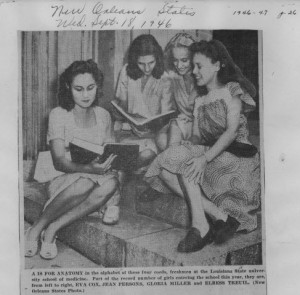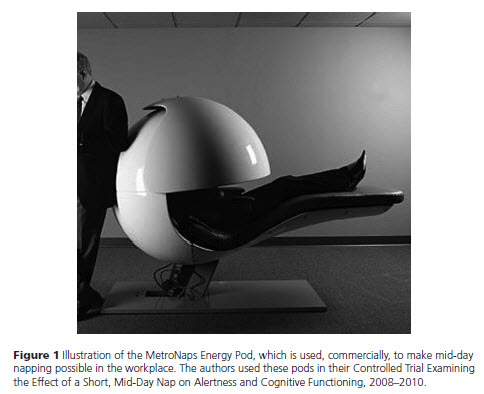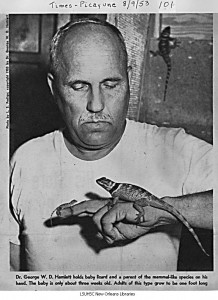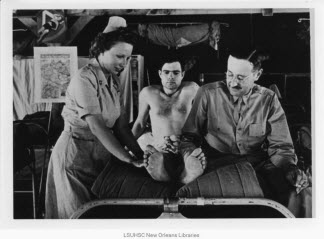 AugustÔÇÖs featured faculty publications are now on display. This month, we are highlighting nine new articles, rather than our regular eight … Bonus! These articles, authored by LSUHSC-NO researchers, have been added to the display in the LibraryÔÇÖs Reference area (near the Library elevator) on the third floor of the Resource Center Building. These items are also part of the LibraryÔÇÖs Faculty Publications Database.
AugustÔÇÖs featured faculty publications are now on display. This month, we are highlighting nine new articles, rather than our regular eight … Bonus! These articles, authored by LSUHSC-NO researchers, have been added to the display in the LibraryÔÇÖs Reference area (near the Library elevator) on the third floor of the Resource Center Building. These items are also part of the LibraryÔÇÖs Faculty Publications Database.
The Faculty Publications Database includes publications authored by at least one member of the LSUHSC-New Orleans faculty, 1998 ÔÇô present. Access to this database is available to the public. The database is linked from the Library web page?áhere. This page includes a handy link to a?áPDF?áof the monthly bibliography of display articles. To add your faculty publications, or for questions about this database, contact?áKathy Kerdolff.
LSUHSC-NO authors are shown in bold print:
1. Brown A, Hirsch R, Laor T, Hannon MJ, Levesque MC, Starz T, Francis K, Kent Kwoh C. ÔÇ£Patients with juvenile idiopathic arthritis in clinical remission have evidence of persistent inflammation as revealed by 3T MRI.ÔÇØ?áArthritis Care & Research (Hoboken).?á2012; epub ahead of print.
2.?áDesai SD, Reed RE, Burks J, Wood LM, Pullikuth AK, Haas AL, Liu LF, Breslin JW, Meiners S, Sankar S. ÔÇ£ISG15 disrupts cytoskeletal architecture and promotes motility in human breast cancer cells.ÔÇØ?áExperimental Biology & Medicine.?á2012; 237(1):38-49.
3.?áHanna EB, Chen AY, Roe MT, Saucedo JF. ÔÇ£Characteristics and in-hospital outcomes of patients presenting with non-ST-segment elevation myocardial infarction found to have significant coronary artery disease on coronary angiography and managed medically: Stratification according to renal function.ÔÇØ?áAmerican Heart Journal.?á2012; 164(1):52; 57.e1.
4.?áParsons HM, Harlan LC, Lynch CF, Hamilton AS, Wu XC, Kato I, Schwartz SM, Smith AW, Keel G, Keegan TH. ÔÇ£Impact of cancer on work and education among adolescent and young adult cancer survivors.ÔÇØ?áJournal of Clinical Oncology.?á2012; 30(19):2393-2400.
5.?áPincus SH, Moran E, Maresh G, Jennings HJ, Pritchard DG, Egan ML, Blixt O. ÔÇ£Fine specificity and cross-reactions of monoclonal antibodies to group B streptococcal capsular polysaccharide type III.ÔÇØ?áVaccine.?á2012; 30:4849-4858.
6.?áSasapu A, Casperson JB, Arcement CM, Gedalia A. ÔÇ£Prolonged and persistent hip pain: Report on two children.ÔÇØ?áClinical Pediatrics.?á2012; 51(7):694-696.
7.?áGiarratano GP, Savage J, Rick S, Harville E, de Mendoza VB. ÔÇ£Disaster and Diaspora: Mental Health Status of Childbearing Women Living Through Disaster Recovery.ÔÇØ Journal of Obstetric, Gynecologic, & Neonatal Nursing, Special Issue: 2012 Convention Proceedings. 2012; 41(s1): S128.
8.?áde Mendoza VB, Savage J, Harville E, Giarratano GP. ÔÇ£Prenatal care, social support, and health-promoting behaviors of immigrant Latina women in a disaster recovery environment.ÔÇØ Journal of Obstetric, Gynecologic, & Neonatal Nursing, Special Issue: 2012 Convention Proceedings. 2012; 41(s1): S133.
9.?áXu J, Zhang J, Chen C. ÔÇ£Long-lasting potentiation of hippocampal synaptic transmission by direct cortical input is mediated via endocannabinoids.ÔÇØ?áJournal of Physiology.?á2012; 590(10):2305-2315.

 myLSUHSC
myLSUHSC






